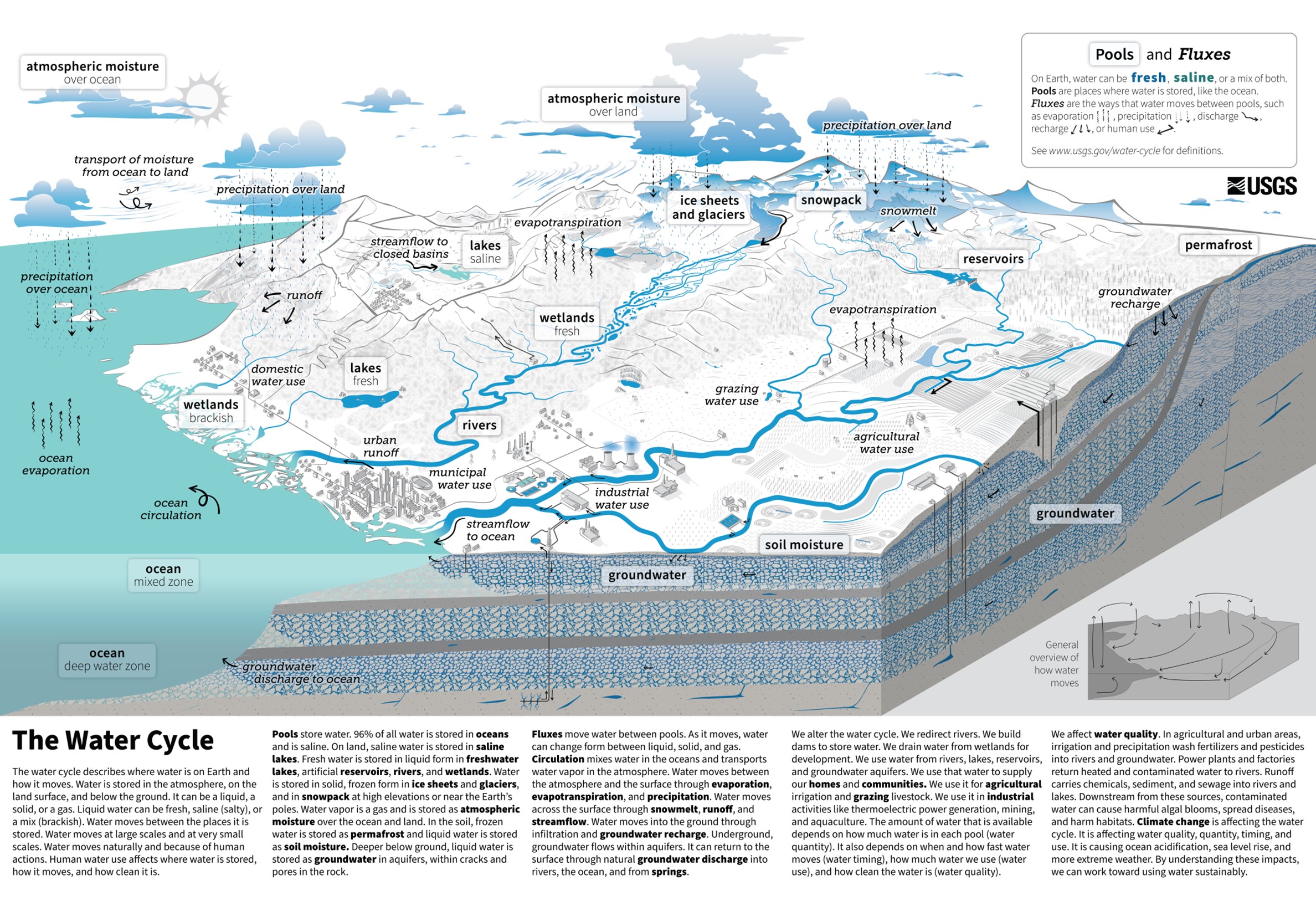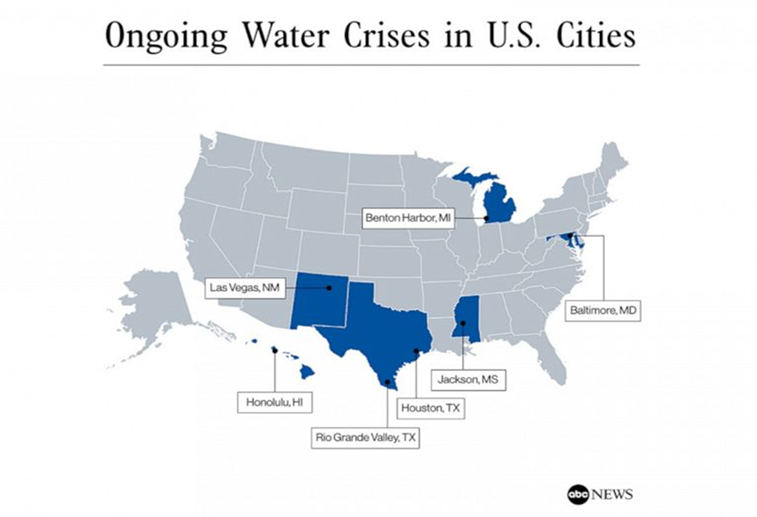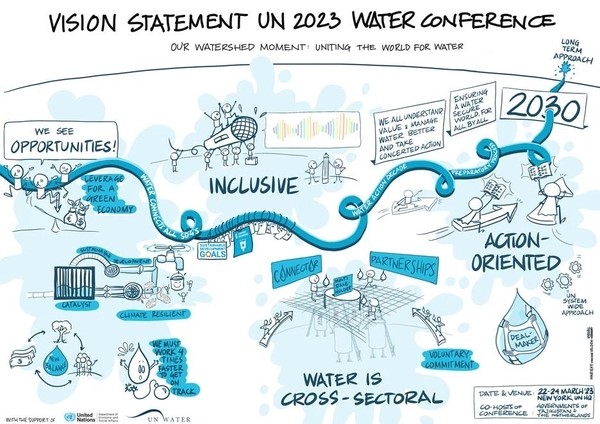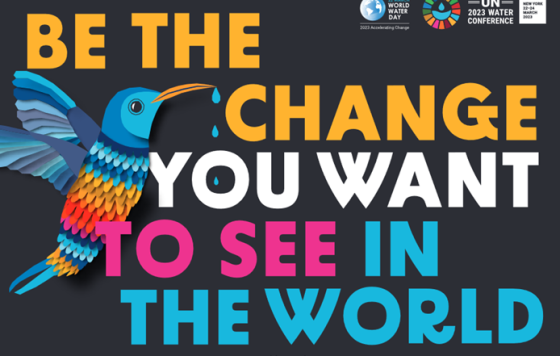With today being World Water Day, I find myself thinking about the policies, practices, and people (The 3-P’s) that create and support inequitable access to water both here in the US and abroad. The power of the 3-P’s on water is where our conversation will begin and end in an effort to uplift our shared humanity and responsibility in protecting this sacred resource that is essential to the existence of many life forms, including our own. Before exploring the power of the 3-P’s on water, let us root our understanding with just a few truths about our precious water resource:
- Water covers about 71% of the earth's surface,
- Earth’s hydrological (water) cycle describes where water is and how it moves (Figure 1)
- 97% of the earth's water is found in the oceans (too salty for drinking, growing crops, and most industrial uses except cooling)
- 3% of the earth's water is fresh
- 2.5% of the earth's freshwater is unavailable: locked up in glaciers, polar ice caps, atmosphere, and soil; highly polluted; or lies too far under the earth's surface to be extracted at an affordable cost
- 0.5% of the earth's water is available freshwater

It is this last truth that ultimately shapes our values (economic, political, social and cultural) which are then placed upon this natural resource and guides the 3-P’s (policies, practices, and people) we will now explore.
POLICIES
Policies relating to the 0.5% of available freshwater cycling through Earth’s hydrological cycle (Figure 1) have been greatly influenced by systemic anthropogenic (man-made) activity. The impact of continued poor water policy implementation and enforcement has had a global impact as evident in 2015 with the adoption of The 2030 Agenda for Sustainable Development and Sustainable Development Goal (SDC) 6: Clean Water & Sanitation by all United Nation Member States. Sustainable Development Goal 6 offers us new guidance, targets and indicators to ensure the availability and sustainable management of water and sanitation for all. So how are we doing?
According to the 2022 SDG 6 progress summary:
- Billions of people will lack access to these basic services in 2030 unless progress quadruples.
- Demand for water is rising owing to rapid population growth, urbanization and increasing water needs from agriculture, industry, and energy sectors.
- Decades of misuse, poor management, overextraction of groundwater and contamination of freshwater supplies have exacerbated water stress.
- Countries are facing growing challenges linked to degraded water-related ecosystems, water scarcity caused by climate change, underinvestment in water and sanitation and insufficient cooperation on transboundary waters.
Here in the US, according to Time, the water crisis is something no one in America is fixing. Over the last decade, we have seen numerous failed policies that weakened the infrastructure (physical and social) and created inequitable access to clean water and sanitation. For example, in the water crisis in Flint Michigan (which began in 2014 before the UN adaption of the 2030 Agenda for Sustainable Development):
- Governmental officials switched its drinking water supply from Detroit’s system to the Flint River in a cost-saving move;
- Inadequate treatment and testing of the water resulted in a series of major water quality and health issues for Flint residents’;
- Complaints of foul-smelling, discolored, and off-tasting water flowing into Flint homes was causing skin rashes, hair loss, and itchy skin were chronically ignored, overlooked, and discounted by government officials for 18 months;
- The Michigan Civil Rights Commission, a state-established body, concluded that the poor governmental response to the Flint crisis was a “result of systemic racism.”
In September 2022, ABC News explored the ongoing water crises in the U.S. Cities, highlighting seven cities (Figure 2):

Figure 2. Map of ongoing water crises in the U.S. Cities
In the following three cities:
1. Houston, Texas
- More than 2 million people in the Houston area had to boil their water before using it to cook, bathe and drink after a power outage at a water purification plant caused low water pressure
2. Jackson, Mississippi
- Most of the city's 150,000 residents had been on a boil water notice since July 29 2022 because the state health department found cloudy water that could cause digestive problems.
- Many were left without any water at all after a major pump at the city’s main treatment facility was damaged in late August 2022.
- The city could not produce water for necessities as important as fighting fires or flushing toilets.
3. The Rio Grande Valley and Surrounding Areas
- Pressures from an ongoing drought and a looming water shortage, caused disaster declarations to be issued in August 2022.
- Reservoirs in the area are drying up, threatening the water supply for millions, as well as threatening the billion-dollar agriculture industry in the area.
The chronic and systemic impact of poor U.S. environmental policies most recently reared its head yet again, twice:
1. On Feb. 3, 2023:
- A freight train of about 50 cars (operated by Norfolk Southern) derailed in a fiery crash on the outskirts of East Palestine, Ohio,
- Eleven of the derailed cars were transporting hazardous materials, five of which contained vinyl chloride and several others were carrying ethyl acrylate and isobutylene,
- the environmental disaster killed thousands of fish in nearby streams and has triggered growing concerns over the impact on residents’ health and on the village’s surface, ground, and well water, and
2. During the week of March 13, 2023:
- Minnesota officials revealed to the public that they had been monitoring 400,000 gallons of radioactive tritium water that leaked from a nuclear generating plant owned Xcel Energy by near Minneapolis,
- It was first confirmed on Nov. 22, 2022, in a notification to the state and the U.S. Nuclear Regulatory Commission
- According to Xcel Energy, it was not revealed to the public until now because it "poses no health and safety risk to the local community or the environment.”
So how are we doing, as the world gathers at the UN headquarters in New York this week? Both home and abroad our progress on SDG 6 and subsequent targets remain alarmingly off track and the health and prosperity of humanity, life and our planet remains at jeopardy. What we must do about the global water crisis brings us to the power of the last two P’s, practices and people.
PRACTICES AND PEOPLE
Practices (behaviors) and people (beings) must be explored together as the various expressions of human culture have greatly influenced our relationships with ourselves, each other, other life forms, and our planet. If ecology is the study of the relationships between living organisms and their physical environment, then the current global water crisis is calling for us to critically reexamine and understand the ecology of our humanity in relation to ourselves, other living organisms, and our sacred, shared, physical resource, water. Again, let us root our understanding in a few truths about the types of ecological relationships that exist.
- Competition—when two or more organisms rely on the same environmental resource
- Predation—behavior of one animal feeding on another
- Symbiosis—the close relationship of two dissimilar organisms, which can be:
- Mutualism—a symbiotic relationship where both organisms benefit
- Commensalism—a symbiotic relationship where one organism benefits and one does not benefit but is unharmed
- Parasitism—a symbiotic relationship where one organism benefits and one is harmed
At the core of all ecological relationships lies the hard reality of the: positive, negative or neutral effects on either organisms’ ability to survive. Unlike other life forms, humans have the ability to make conscious decisions regarding the type of ecological relationship we will establish with one another and other life forms on this planet. The power of our practices and us as a people, begins when we are in mutualistic symbiotic relationship with one another.
Next week (March 22-24 2023) at The UN 2023 Water Conference, we have an opportunity and responsibility to reexamine the power of the 3-P’s and its impact on clean water and sanitation.
This World Water Day is about accelerating change to solve the water and sanitation crisis and being the change in the world we want to see. RIGHT NOW, WE FACE A WATER AND SANITATION CRISIS. DO WE STAND AND STARE? OR, DO WE ACT?
WE ACT, remembering the ancient story of the hummingbird:
“One day in the forest, a fire broke out.
All the animals ran for their lives.
They stood at the edge of the blaze, looking at the flames in terror and sadness.
Up above their heads, a hummingbird was flying back and forth to the fire, over and over again.
The bigger animals asked the hummingbird what she was doing.
“I am flying to the lake to get water to help put out the fire.”
The animals laughed at her and said, “You can’t put out this fire!”
The hummingbird replied, “I’m doing what I can.”
WE ACT, being like the hummingbird, shifting the Power of the 3 P’s (Policies, Practices, and People) towards a global, mutualistic water vision that restores our humanity and our planet, “Our watershed moment: uniting the world for water”

https://www.unwater.org/news/un-2023-water-conference
Sources
1The 3-P’s (policies, practices, and people) is a social framework and perspective (taught by Wekesa and Afiya Madzimoyo of AYA Educational Institute) that provides a starting, point for addressing and challenging inequities
2https://www.usbr.gov/mp/arwec/water-facts-ww-water-sup.html
3https://www.usgs.gov/special-topics/water-science-school/science/water-cycle-diagrams
4https://sdgs.un.org/goals/goal6
5https://time.com/6255560/water-sanitation-crisis-ohio-train-derailment/
6https://www.nrdc.org/stories/flint-water-crisis-everything-you-need-know#sec-summary
7https://abcnews.go.com/US/map-ongoing-water-crises-happening-us-now/story?id=89454219
8https://abcnews.go.com/US/east-palestine-derailment-timeline-key-events-toxic-train/story?id=97522161
9https://abcnews.go.com/US/cleanup-underway-after-400000-gallons-radioactive-water-leaked/story?id=97951102
10https://sdgs.un.org/conferences/water2023
11https://www.nationalgeographic.org/activity/ecological-relationships/



